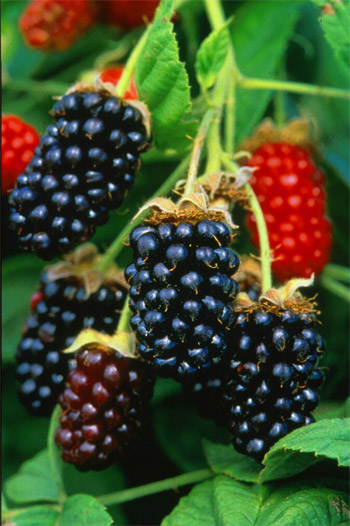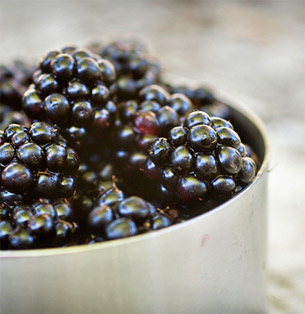|
|
|
 , ,
Font size |
Encyclopedia of Health Benefits of Berries

20. Marionberries:
These are a cross between Chehalem and Ollallieberry. They are glossy
and darker than blackberries and are used to prepare pies, ice creams, jellies,
etc.
Oregonians just can�t keep Marionberries a secret any longer. Long revered in
the West as a culinary treasure, Marionberries are finally out of the closet and
into the kitchens of celebrated and little known chefs everywhere.
Marion Blackberry or Marionberry. Introduced by George F. Waldo in 1956 and
adapted to Western Oregon, the Marionberry is named after Marion County, where
it was tested extensively. The berry is medium to large, round and somewhat
longer than wide. The Marionberry is a trailing vigorous grower, generally
producing only a few long canes which grow up to 20 feet. The spines are large
and numerous, and fruiting laterals are long and strong, with many fruit. The
Marionberry produces up to 5-6 tons per acre. Marionberries
are quality berries, with a better flavor than the Boysen or Evergreen.
Marionberries are well-suited for use in local fresh markets and for commercial
or home canning, freezing, pies, ice cream flavoring, jams, and jellies.
Admired for their unique and complex flavor profile, Marionberries have an
essence that captures the warmth of a summer day in the great Northwest and
releases it in your mouth like a lovely memory. Their vibrant purple color packs
a powerful nutritional punch that catapults Marionberries to the top of the
antioxidant charts. With an underlying earthiness, hints of sweet and a lively
tartness, wholesome Marionberries present an explosion of flavor and well-being
that is larger than life.
Oregon�s Willamette Valley has long been considered to be berry paradise by
fruit buyers and berry devotees worldwide, with over 50 varieties of berries
cultivated for sale to worldwide markets. A unique maritime climate with long,
mild spring weather allows Oregon berries to grow slowly, creating a tapestry of
rich and intense flavor compounds.
Cool summer evenings send Oregonians for their jackets, but allow the berries
more hang time to plump up and approach ripeness with repose. In Oregon, we
don�t allow our berries to grow up too quickly!
Picked fresh from July to August, Oregon farmers grow 30 million pounds of
Marionberries yearly. With over 100 years in the berry business, Oregon�s
growers and processors are experts in cultivation, harvesting techniques and
processing technology. Marionberries picked at the peak of ripeness can be
cooled and individually frozen within hours, providing consumers with a
perfectly ripened berry year round. Yet, when thawed, Oregon Marionberries keep
their shape, providing integrity for beautiful sauces and garnish, or for eating
by the bowlful.
Marionberries are also available in puree, concentrate, block frozen, dried,
freeze-dried and canned forms. The alluring flavor and aroma of the Marionberry
is becoming legend, with national companies including Orange Julius, Trader
Joe�s, Costco and Starbucks forging the Marionberry trail. Traditionally used in
pies, jams, syrups, and cobblers, Marionberries� wide appeal now includes
smoothies, ice cream and sorbets, sweet or savory sauces, marinades, and upscale
desserts.
 Scientists now believe our most powerful medicinal tools reside in our
refrigerators, not our pharmacies. Colorful fruits and vegetables contain potent
phytochemicals that help our bodies fight heart disease, aging and cancer.
Marionberries, with their vibrant purple color, contain strong antioxidants -
powerful natural zappers of free radicals, the unstable oxygen compounds in our
bodies that are associated with heart disease and the effects of aging.
Phytochemicals, such as ellagic acid, anthocyanins and other phenolic compounds
in Marionberries have been found to have anticarcinogenic properties. Scientists now believe our most powerful medicinal tools reside in our
refrigerators, not our pharmacies. Colorful fruits and vegetables contain potent
phytochemicals that help our bodies fight heart disease, aging and cancer.
Marionberries, with their vibrant purple color, contain strong antioxidants -
powerful natural zappers of free radicals, the unstable oxygen compounds in our
bodies that are associated with heart disease and the effects of aging.
Phytochemicals, such as ellagic acid, anthocyanins and other phenolic compounds
in Marionberries have been found to have anticarcinogenic properties.
Health Benefits of Marionberries
High in ellagic acid (5.83 mg/g), which is known to help prevent cancer.
High in antioxidants (28 μmole per gram, compared to 24 per gram in
blueberries.)
Contains high levels of strong antioxidants such as Vitamin C, gallic acidand
rutin that help promote circulatory health and fight against cancer.
Contains high levels of anthocyanins (109-155 mg per 100g),which can also
protect against cancer, heart andcirculatory diseases and age-related mental
decline.
Eating whole berries has been shown in scientific studies to be morebeneficial
that taking the individual phytochemicals (a class of healthful chemical
substances found in plants) in the form of dietary supplements.
Next..
Dated 12 March 2013

|
|
|
|
|
|
|









